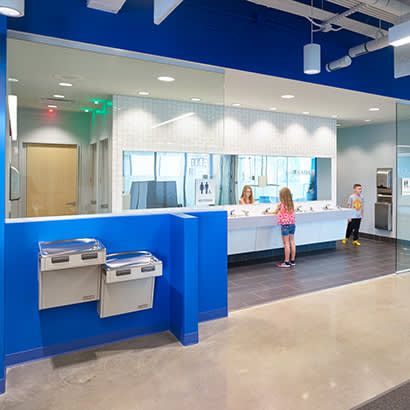
Creating welcoming public facilities that truly serve
Public facilities, by definition and mission, aim to inclusively serve their communities. Today, the definition of “inclusion” is broader than ever, raising questions about how public institutions must adapt in order to be inclusive for all. A recent reckoning with this topic came in the form of a 2017 lawsuit against an Illinois school district, where a student was denied the use of locker room facilities because she was transgender. The case reinvigorated conversations about how to accommodate the needs of all users in public facilities.
In our work, this topic frequently arises, as clients and their communities seek to better understand how design can help them become more accessible. We, in turn, look to research and informed conversations with users to see how we can help clients put inclusivity into practice.
What Does Inclusion Mean?
Gender is often central to these discussions, as more people today feel safe to express themselves in ways that challenge traditional norms. However, as institutions explore how best to serve diverse user groups, our experience has shown us that the dialogue we should be having about inclusion isn’t about gender at all: it’s about privacy. Though inclusion has recently become a political flashpoint, we must acknowledge that inclusive public facilities that grant users more privacy have been around for years. Consider, for example, the widely accepted family changing rooms that quietly became common several decades ago. These larger spaces have improved access for parents with small children, the elderly and adults who require a caretaker.
By using this concept as a jumping off point, communities can consider how to design for the needs of today’s diversifying user groups. Privacy — the ability to choose how and whether to seclude oneself in order to carry out a task, like changing clothes or using the restroom — often determines one’s decision to use a facility at all. Gender is rarely the only key driver in inclusive design, but it is a challenge frequently faced by members of the transgender community, among other user groups.
A 2016 study from the National Center for Transgender Equality reports: “Twelve percent of transgender people were verbally harassed in public restrooms within the previous year, 1 percent were physically attacked and 1 percent were sexually assaulted. Nine percent said someone denied them access to a bathroom.” Out of fear of confrontation, almost 60 percent of transgender people have avoided using restrooms. This is reinforced by a 2018 study from the Williams Institute at UCLA School of Law, which again reports higher rates of harassment among facilities that do not provide adequate privacy for users regardless of gender, age or ability.
Lack of acceptance sends an unwelcoming message from public institutions and blocks access for many. For park districts, especially, tight-knit communities are essential to success and paramount to their missions. If organizations, architects and community members do not intentionally create inclusive spaces, it sends a clear message that certain community members are not welcome.
Fostering Empathy via Design
How can we, a diverse society of people with different abilities and sensibilities, cultivate empathy? The 2010 U.S. Census notes that nearly 1 in 5 Americans has a disability. The report also states that new disabilities continue to emerge. Some 20 percent of listed disabilities are not visible: these can include autism, arthritis, asthma, hearing impairment and learning disabilities.
In Indiana, 19 municipalities passed a 2016 Gender ID ordinance, which allows residents to use any public restroom according to their self-identified gender. As design began in 2017 on West Lafayette’s Wellness and Aquatic Center — a new public facility in West Lafayette, Indiana — elected officials and project leaders from the city stated one of the project’s core missions: to provide holistic wellness and recreation opportunities for all community members in the spirit of service and inclusion. The facility is scheduled to open in 2020, with inclusive restrooms and locker rooms that provide all building users enhanced opportunities for privacy.
Timothy Clark, facilities director, ADA/Title VI coordinator - risk management for the city of West Lafayette, states: “The new inclusive locker rooms planned for the West Lafayette Wellness and Aquatic Center will directly impact my family’s ability to use the new facility. Having access to an inclusive changing room with adaptive changing table will allow me to assist my daughter, who has special needs, in a private and dignified way. I’m proud that we have the resources to provide this for our community.”
For existing buildings, the question “why should I restructure my facility now?” must be asked carefully. Assuming users with specific needs will just adapt is not realistic and, particularly, discriminates against people with disabilities. Operators of public facilities must consider barriers to access and look for modifications to ensure each person’s privacy is respected.
We believe our society can make room for diverse needs. We are capable of empathy. Barriers to access in public facilities — open showers or gendered restrooms, for example — are often outdated social concepts and unnecessary. It is important to remember that privacy is at the core of every conversation about inclusion: the desire to use facilities that are easier and safer for users regardless of their ability, gender, age or family status stems from our basic human need to belong. If we look past politicized views on inclusion, by understanding individuals’ preferences and abilities, we can create welcoming spaces that truly serve.
Lindsey Peckinpaugh, AIA, LEED AP, RELi AP, is the Principal: Sports, Recreation, and Entertainment Practice Leader for Perkins and Will. Jenny Stephens is the Principal: Marketing Director for Perkins and Will.

